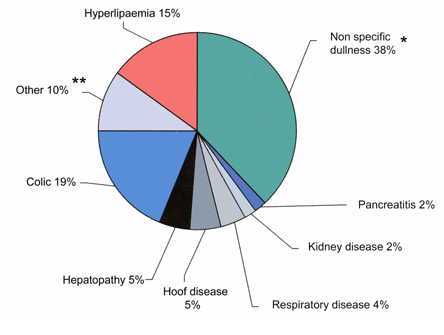Difference between revisions of "Causes of dullness - Donkey"
Jump to navigation
Jump to search
m (Text replace - '{{review}}' to '') |
(New page: {{review}} center * * Non-specific dullness: no abnormalities detected on clinical examination, complete blood count or biochemical analysis. * ** Other ...) |
||
| (2 intermediate revisions by the same user not shown) | |||
| Line 1: | Line 1: | ||
| − | + | {{review}} | |
[[Image:Causes of dullness.jpg|center]] | [[Image:Causes of dullness.jpg|center]] | ||
| Line 39: | Line 39: | ||
|linkpage =Dull Donkey | |linkpage =Dull Donkey | ||
|linktext =Dull Donkey | |linktext =Dull Donkey | ||
| + | |rspace={{Donkey}} | ||
|pagetype=Donkey | |pagetype=Donkey | ||
}} | }} | ||
| − | |||
| − | |||
| − | |||
| − | |||
| − | |||
[[Category:Donkey]] | [[Category:Donkey]] | ||
Revision as of 21:08, 19 February 2010
| This article has been peer reviewed but is awaiting expert review. If you would like to help with this, please see more information about expert reviewing. |
- * Non-specific dullness: no abnormalities detected on clinical examination, complete blood count or biochemical analysis.
- ** Other causes of dullness diagnosed in donkeys at The Donkey Sanctuary in the time period considered include:
- Arthritis
- Pyrexia
- Dental disease
- Anaemia
- Neuropathy
- Acetylpromazine administration
- Hyperlipaemia with pancreatitis
- Hyperlipaemia associated with azotaemia and liver damage
- Coagulopathy
- Hypoalbuminaemia
- Multiple geriatric problems
- Necrotic stomatitis
- Fracture
- Loss of companion
- Oesophageal problem
- Lyme disease
- Mandibular fistula
- Injection abscess
- Septicaemia
- Ocular disease
- Cellulitis around lips
The causes of dullness have been reviewed in the Donkey Sanctuary’s population (Duffield et al, 2002) and the results are shown above. It is essential that the practitioner considers these differential diagnoses when attending a dull and depressed donkey. At the Donkey Sanctuary there is a high detection rate of dullness in the donkeys as the staff are aware that subtle changes in behaviour can be an indicator of serious diseases. They also have frequent and easy access to a vet. This means that there is a high incidence of ‘non-specific’ dullness in the Sanctuary’s donkey population.
References
- Duffield, H. (2008) An approach to the dull donkey In Svendsen, E.D., Duncan, J. and Hadrill, D. (2008) The Professional Handbook of the Donkey, 4th edition, Whittet Books, Chapter 2
- Duffield, H.F., Bell, N., and Henson, M.D. (2002). The 7th International Equine Colic Research Symposium Handbook. p 122. Manchester, 14-16 July 2002.
|
|
